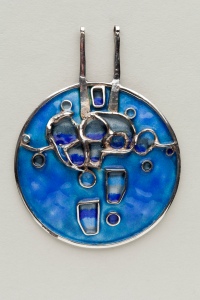Six pieces of jewellery and a silver and enamel pill box by Norman Grant acquired by Aberdeen Art Gallery and Museums in 2015 with an NFA grant of £1,587.
In May 2014 I wrote a post on a brooch and pendant by North East Scotland’s own Norman Grant, acquired for our collection with NFA funding.
All that glisters is not gold … it’s very often silver
With our increased knowledge about the pieces Grant created, and access to his original sketchbooks and designs, we have acquired seven other examples of Grant’s beautiful enamelled work, again with NFA support.
Norman Grant was born in Forres, Moray in 1943 and studied at Gray’s School of Art in the 1960s. He was a student of David Hodge who established a goldsmithing and jewellery course at Gray’s in 1954, leading the department until he retired in 1975. Hodge remembered Grant as one of the students who made his teaching career memorable.
In the late 1960s Grant began to design jewellery, initially working in a shed in his garden. His preferred medium was translucent enamel which he combined with sterling silver. The comparatively low cost of materials enabled him to be experimental in his work while keeping the cost to the customer reasonably low. Knowing that to be successful he had to sell, Grant showed examples of his work to local jewellers and was surprised when all the pieces sold in one morning. Right away Grant found himself working full time to complete orders and within a year the popularity of his work was assured. With its psychedelic colours and Pop Art patterns, his jewellery reflected the fashion and style of the period.
Having initially studied graphic design before switching to silversmithing, Grant often maintained that he was influenced by the natural forms of the coastal landscape he had grown up with. Inevitably these influences found their way into his early jewellery designs; microscopic plant cell structures, petals, stamens, seed heads, trees, driftwood, shells, seaweed, anemone-like forms and later fish, wave and cloud motifs can all be seen in his work.
Gold and Moss Agate Frog and Lily Pad Pendant is an example of Grant’s later work and reflects his love of the natural world. Not only does the pendant incorporate a frog and lily pad but the pond is made from a piece of pale moss agate. Scottish moss agates are primarily found in Fife where Grant’s workshop was established, forging another link with the geology of the area. The pendant and chain are made of gold although Grant worked predominantly in silver during this period.
Often Grant’s designs were made up in the workshop by one of his silversmiths but we know that Stickleback Motif Blue Pendant was made by Grant himself. Grant’s original design brochures feature this pendant as design number PG17. The piece is finished in vitreous glass (kiln-fired) enamel in translucent shades of cobalt, aqua, and sky blue set within the silver cells which form the abstract outline of a stickleback fish and give the pendant a kaleidoscopic effect.
Rock Pool and Reflections Pendant, made in 1978, is a variation on the theme of ‘organic’ designs. We now know that the ‘silver and enamel pendant’ featured in my last post should more correctly be called Rock Pool Pendant. The two are linked in their circular form, redolent of areas of sea water contained by the rocks around them.
Eight Enamel Panelled Necklet is part of the ‘Mexican Blanket’ series which also includes the enamel brooch discussed in my previous post. It has been a very rewarding process to work with some of the original design sources in order to positively identify the prototypes. The series derives from the traditional Mexican saltillo (or serape) blanket design which dates back to the Chichimeca people of pre-colonial times. The necklet is formed of eight irregular panels of coloured enamel with silver borders and seven ball and chain features suspended below. The pendant is attached to a thin silver torque. It was made in 1972 at a time when Mexican culture was becoming increasingly popular as a result of the social, political and cultural Chicano Movement.
Silver and Titanium Parrot Pendant is from Grant’s ‘Titanium Futuristic Jewellery’ collection of the late 1970s and early ’80s which included pendants, earrings, brooches and bangles. This is very different in style to his earlier work. Titanium jewellery became fashionable during this period as designers sought to move away from more traditional metals. Developed for use in the aerospace industry, titanium is a light, strong metal that can be anodized to create a variety of vivid colours. This is achieved by passing an electric current through the metal. The parrot was one of the most difficult pieces of titanium jewellery made by Grant owing to its curved and uneven surface which exacerbated the difficulty of making titanium adhere to silver. Later titanium pieces by Grant are often unmarked and can only be identified by style. The parrot pendant, however, bears Grant’s ‘NG’ punch mark.
This small pill box is one of a limited edition. The decorative enamel lid suggests a cross-section of a plant, the granulated orange and pink sections similar to the cells of a seed head.
Similarly, Honesty Brooch/Pendant illustrates Grant’s fascination with plant life. Whereas the structured lines or septa of the pill box are formed of grey enamel, the septa on the brooch forming the structure of the cross-section are slightly raised ridges of silver, the enamel poured in around them.
Support from the National Fund for Acquisitions has allowed us to continue to acquire pieces by this creative and highly individual designer and to increase our knowledge of his design methods, his breadth of style and the ideas which inspired him.
Vikki Duncan
Curator of Decorative Art
Aberdeen Art Gallery












